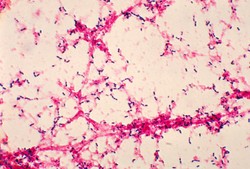Human infection with Streptococcus pneumoniae is well-known across the globe, and in the United States it is responsible for 400,000 hospitalizations every year. Death from it occurs mostly in developing countries. Worldwide, it kills more than a half million children less than the age of five each year [1, 2, 3].
Though penicillin has long been an effective agent to treat this type of pneumonia, there have been problems with antimicrobial resistance which make it difficult to manage. The microbe is a Gram-positive, lancet-shaped, facultative anaerobic bacterium which occurs mostly in pairs; however, it may also appear singly or in chains [1, 2, 3].
The microscopic appearance of pairs is why microbiologists have referred to it as Diplococcus pneumoniae several decades ago as “diplo” implies occurrences of “two.”




 The Reality of Aspirinon 05/24/2021
The Reality of Aspirinon 05/24/2021
 An Old Microbeon 03/31/2021
An Old Microbeon 03/31/2021
 Coronavirus and Mental Illnesson 02/14/2021
Coronavirus and Mental Illnesson 02/14/2021
 Acute Ischemic Strokeon 12/25/2020
Acute Ischemic Strokeon 12/25/2020


Comments